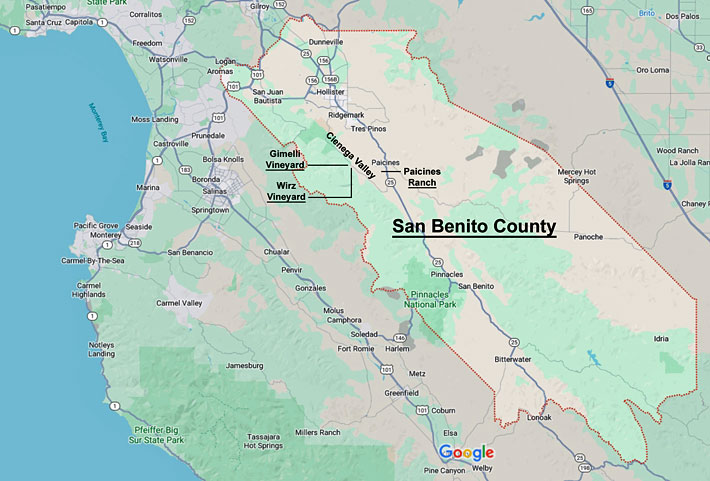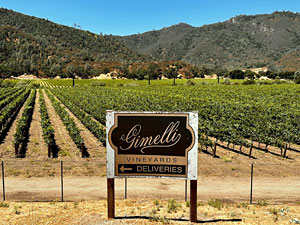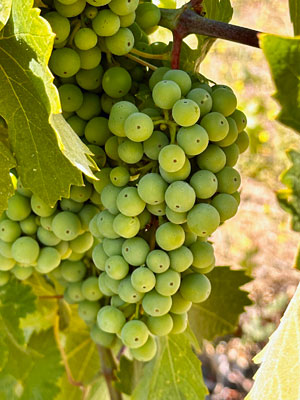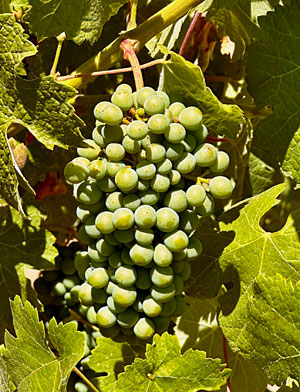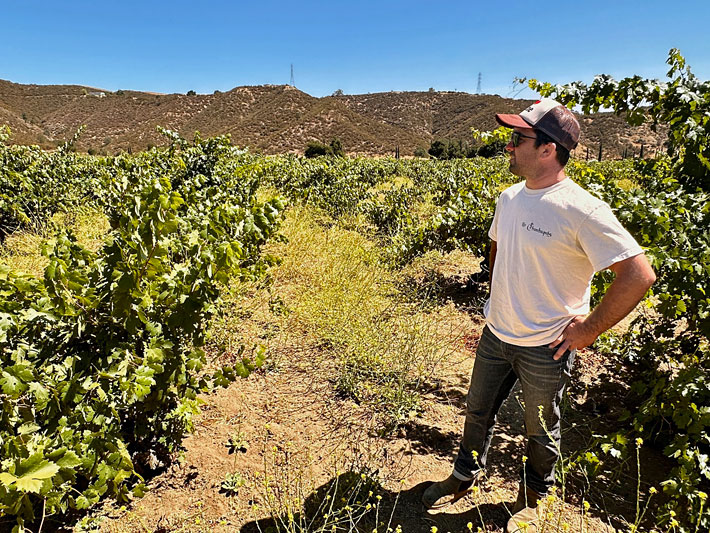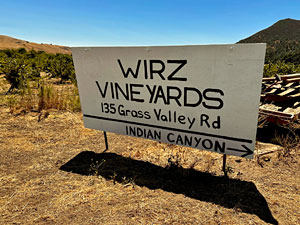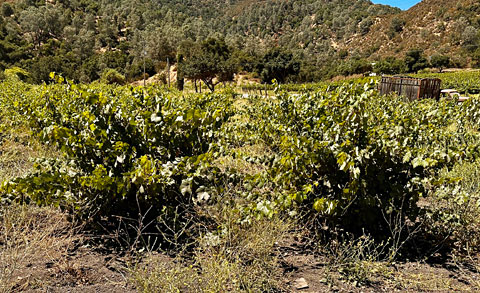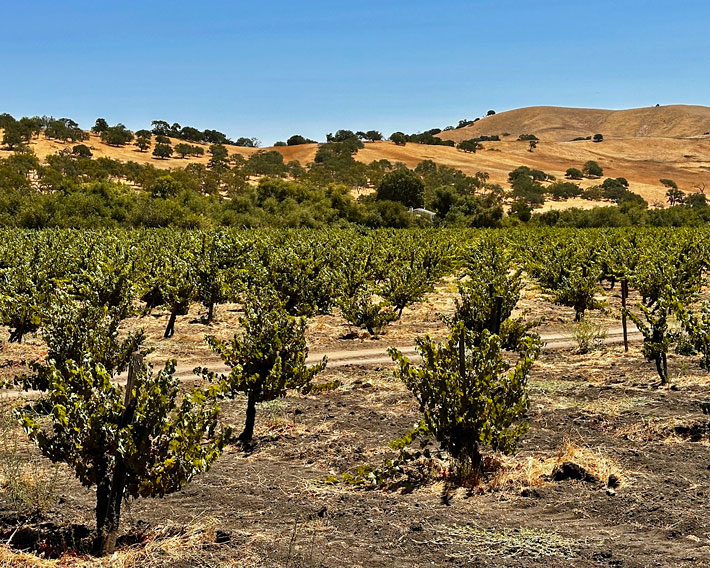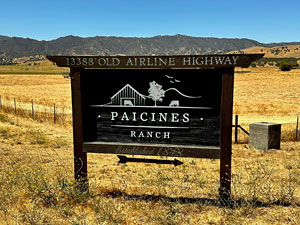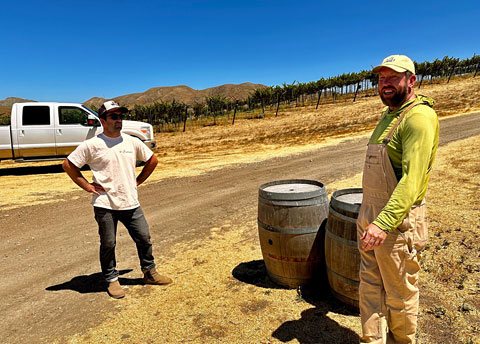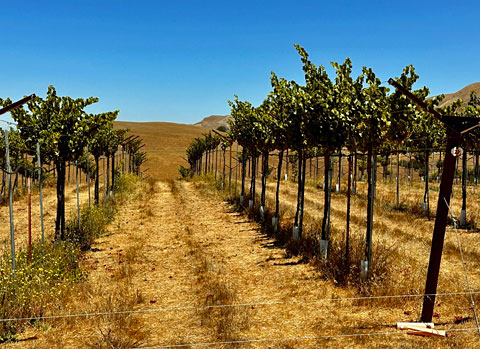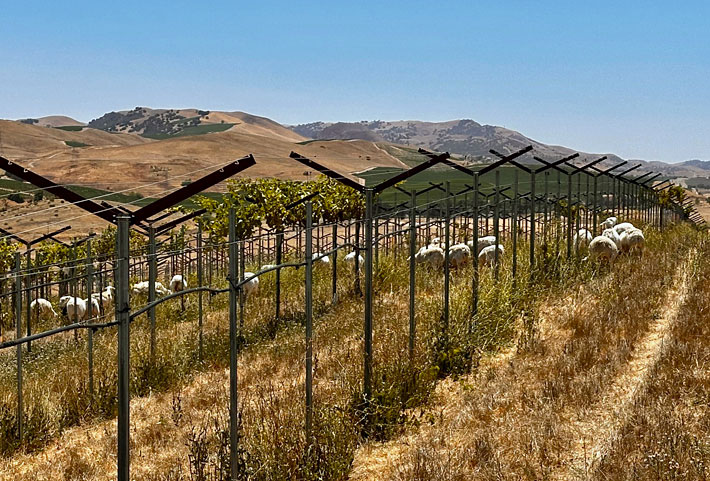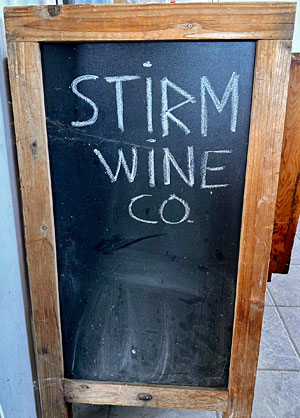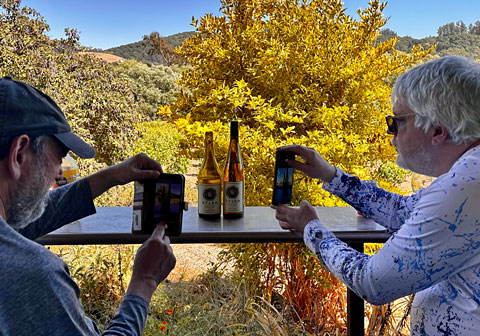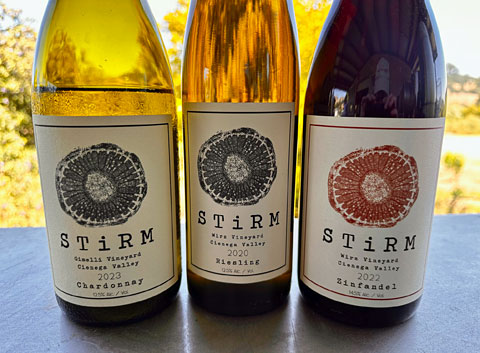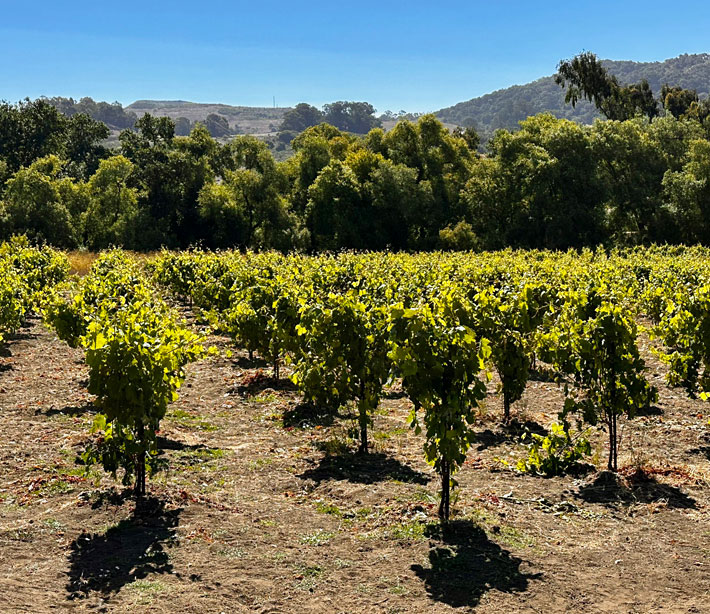San Benito Vineyards and Wine - July 2025
I’ve made an effort over the past year or so to explore the vineyards and wineries of San Benito County. Though it’s been a winegrape-growing region since the early 1850s and as recently as 50 years ago had thousands of acres under vine, it’s not well-known among most wine lovers, even those who particularly enjoy California wine.
Along with friends, I visited Siletto Family Vineyards plus Blade and Talon Wine and Stirm Wine Co. in 2024, and earlier this year I visited Randall Grahm’s Popelouchum Vineyard and at DeRose Winery and Eden Rift Vineyards. On this occasion I traveled with friends Wes and Larry to three more San Benito County vineyards, two of them with long histories and one still in the early stages of an exciting regenerative farming project.
As I didn’t have very good contact information at any of the three places I was interested in visiting this time, I reached out to a couple of vintners I’ve known for awhile who work extensively with San Benito County fruit, Megan Bell of Margins Wine and Ryan Stirm of Stirm Wine Co. They were both very helpful, and although Megan wasn’t able to join in on this vineyard tour, Ryan offered to take us to the three vineyards in his truck. It worked out perfectly for him, as he wanted to check on the progress of his fruit at all three sites.
The morning started out overcast, but by the time I picked up Wes and Larry in Mountain View and headed south from there it was already clearing up. We had fine weather all day, warm but not overly hot. We met Ryan at his winery in the small town of Aromas near Watsonville. It’s at the very southern tip of Santa Cruz County, where it meets with both Monterey and San Benito counties.
I provided a brief introduction to San Benito County and its place in California wine history just below, since the region remains so little-known. I’ve included this in my previous San Benito articles, so feel free to skip ahead if you’ve seen it before!
Introduction to San Benito County
The vineyards of San Benito County include some of the older plantings in California, yet they’re not very well-known, even among many fans of California wine. The region is located south of Santa Clara Valley and east of Monterey County, between the Gabilan and Diablo mountain ranges. It’s generally warm during the summer, though afternoon maritime breezes coming down from Monterey Bay and through the Hollister area help to temper the heat. Historically, agriculture and mining (mainly for quicksilver) have been important to the county’s economy. Though mining operations have fallen off, farming and ranching remain strong – apricots have been one of San Benito’s most notable crops over the years. The region includes two major earthquake faults – the San Andreas and Calaveras faults run through the county, contributing to its interesting geology and mix of rock and soil types, including volcanics, decomposed granite, and limestone, as well as some rare minerals. Rock quarries for granite and limestone continue to operate in the Cienega Valley area.
The first commercial winegrape plantings in San Benito County came around 1851, when Frenchman Théophile Vaché planted vines in Cienega Valley, at what are now DeRose and Eden Rift vineyards. It’s been said that some of Vaché’s vines planted in the mid-1850s remain at DeRose. William Palmtag purchased Vaché’s vineyard in 1883 and expanded it, adding more grape varieties. Enz Vineyard, in the same area, may have first been planted as early as the 1880s, and some of those vines are still producing. Other vineyards that were initially planted by the early 1900s include Wirz and Gimelli (formerly El Gabilan). Wirz also has Riesling vines dating to the early 1960s. Josh Jensen began planting his Calera vineyards in the Mount Harlan area in 1974. San Benito County’s vineyard heyday came in the 1970s when wine giant Almaden had over 3,000 acres of vineyards in the area. But that era didn’t last long for the region, and most of those vineyards are gone now. Newer plantings of note in the past 30-40 years include Siletto Family, Vista Verde, Pinnacle, and Paicines Ranch vineyards.
San Benito County includes five AVAs entirely within the county borders: Cienega Valley (1982), Lime Kiln Valley 1982), Paicines (1982), San Benito (1987), and Mount Harlan (1990). There are also three AVAs that are partially within San Benito County, including their most recent one, Gabilan Mountains (2022).
In the past ten years or so, a number of smaller-scale vintners have discovered the vineyards of San Benito County and have sought out fruit from there, particularly older plantings of varieties such as Négrette and Cabernet Pfeffer, which may not be grown anywhere else in California. And the newer vineyards in particular have planted or grafted many varieties originally from Italy, Spain, Greece, France, and elsewhere in Europe that are little-known in California vineyards. Nearly all of these vintners make their wines outside of San Benito County, and there are still very few wineries within the county itself.
Gimelli Vineyard
Ryan drove Wes, Larry, and I southeast from his winery in Aromas, going through the small town of San Juan Bautista and eventually turning onto Cienega Road. As we proceeded south through Cienega Valley, we passed DeRose Winery and Eden Rift Vineyards, where we’d visited a few months earlier, and then soon also passed the road leading up to Calera Wine Company, located higher in the hills of the Mt. Harlan AVA. When we started along Cienega Road, Ryan mentioned how poor the pavement is along much of the road, something that Wes, Larry, and I had certainly noticed on our earlier visit to the area. Ryan said that due to the road condition, it was not his favorite route for hauling a load of grapes back to his winery, and it wasn’t hard to understand why!
Cienega Valley straddles the San Andreas Fault, and the site includes different soil types on either side. The eastern side has clay and sandstone soil, with the higher portions to the west of the fault have more granitic and calcareous soil. Ryan mentioned that the soil on the west side of the fault – where most of the older vines in the area are located – is quite sandy, and this is partly why the old own-rooted vines there have been resistant to phylloxera over the years. The Cienega Valley climate is quite warm during the growing season but winds from Monterey Bay typically cool it off starting in the mid-afternoon so there’s a considerable diurnal temperature swing in the vineyards. The fruit typically retains good acidity due to the cool nighttime temperatures and the wind. Ryan said that there’s adequate groundwater around the valley floor but much less available as you get up onto the surrounding hillsides.
Not far past the road to Calera, Ryan turned west from Cienega Road and into Gimelli Vineyard, in the heart of the Cienega Valley growing region. Originally known as El Gabilan Vineyard, this was the source of vine cuttings that went to a number of other San Benito County vineyards. Probably most of the Cabernet Pfeffer vines that are now grown in San Benito County originated from this vineyard.
The beginnings of Gimelli Vineyard aren’t entirely clear, but it’s likely that about 15 acres of grapevines were planted in the 1890s though those earliest vines at the site may now be gone – it’s unknown who planted them and what variety or varieties were there. In 1907, University of California Viticulture and Enology Professor Frederic Bioletti and physician Dr. Harold Ohrwall purchased the vineyard and began managing it the following year. They planted around 75 additional acres in 1908 and the total vineyard size was up to 100 acres by 1912. Professor Bioletti had gone back to teaching at UC by then, but Dr. Ohrwall built a winery and continued farming the vineyard and making wine there. His El Gavilan Winery survived Prohibition by selling grapes to East Coast home winemakers, and Dr. Ohrwall operated the winery until selling his property to Taylor & Co. in 1944. The property was taken over by Almaden in 1963, and after Heublein acquired that company in 1987 they soon began to liquidate Almaden’s large property holdings. Ken Gimelli purchased the old El Gabilan Vineyard property in 1995 and renamed it Gimelli Vineyard.
Gimelli Vineyard is now about 130 acres in size, on a property of around 350 acres. Ryan told us that the vineyard size was once larger. The site is at an elevation of 900 to 1,000 feet, and has mostly sandy limestone and granite soil. Most of the organically-farmed vineyard contains plantings that Ken Gimelli put in starting around 1997, and it includes Chardonnay, Pinot Noir, Sangiovese, Chenin Blanc, Gamay Noir, Viognier, and Merlot. Only 12.5 acres of the old vines remain, with 7.5 acres of Zinfandel and 5 acres of Cabernet Pfeffer. It’s not known for certain whether these vines pre-date Bioletti and Ohrwall’s involvement in the vineyard but it seems probable that they planted them in 1908.
|
| Old vine Cabernet Pfeffer |
Since Ryan knew that our main interest in visiting Gimelli Vineyard was to see the old vines there, he drove us along the dirt vineyard roads past most of the newer plantings until we came to a block of old head-trained vines – this was the Zinfandel block. We got out of the truck and walked over to take a closer look at the vines. As was the practice when these vines were planted, they’re all own-rooted and dry-farmed. The vines are surprisingly small considering that they’re now well over 100 years old – only a lone Cabernet Sauvignon vine amongst the Zin had the big gnarly trunk you think of when you picture old vines. Ryan was interested in seeing how the fruit clusters were developing, and there was still no sign of veraison on any of the vines we looked at.
We got back into Ryan’s truck and he continued for a short distance farther up the dirt road to the old-vine Cabernet Pfeffer block, probably planted at the same time as the Zinfandel. Like the Zin, these vines are own-rooted, head-trained, and dry-farmed. We quickly noticed that the Cabernet Pfeffer vines are taller and more stout than the Zinfandel vines, with a larger sprawling canopy of leaves. Ryan told us that the large canopy is particularly needed for the Cab Pfeffer, as this variety can more easily get bleached or burned by too much direct sun on the grape clusters. He also noted that the Cab Pfeffer ripens later than the Zinfandel, and he usually brings it in from late September to late October depending on the vintage. As with the nearby Zin vines, we could find no veraison yet in any of the Cab Pfeffer grape clusters that we saw.
In addition to the old-vine Zinfandel and Cabernet Pfeffer, Ryan gets Chardonnay, Sangiovese, and Chenin Blanc from Gimelli Vineyard. A number of other noted vintners source fruit from the site, mostly but not all from the Santa Cruz Mountains and northern Central Coast regions.
|
| Ryan Stirm, with old vine Zinfandel at Gimelli Vineyard |
Wirz Vineyard
After Wes, Larry, and I hopped back into the truck with Ryan, we didn’t have far to go to our next stop of the day. It was just past a fence line to Wirz Vineyard, which is directly adjacent to Gimelli Vineyard to the south. As with Gimelli, it’s just about 1,000 feet in elevation with the same type of sandy granite- and limestone-based soil and the same significant diurnal temperature swing during the growing season. There are a number of different types of limestone, and Ryan said that much of what’s in Cienega Valley limestone is calcite – one of the Stirm wines that Ryan makes is a white blend called “Calcite.” He also noted that while dry-farming grapevines is possible in Cienega Valley, that’s difficult to do just over the hills to the east near Highway 25 (the main highway through San Benito County), where it’s hotter and there is less rainfall, so vineyards in that area are typically irrigated.
Owned by Pat Wirz and his family, Wirz Vineyard is another old one, with 6-7 acres first planted by the Pivetti family around 1902 or 1903. As with many old plantings, there is a mix of varieties interplanted, including Zinfandel, Cabernet Pfeffer, Mataro (aka Mourvèdre), Carignan, Rosa del Peru (aka Mission), and probably a little Palomino and Orange Muscat. An additional planting of similar mixed varieties was added in the 1920s – as with the earlier planting, the vines are head-trained, own-rooted, and dry-farmed. The Pivetti family owned the property until Pat’s father purchased it in 1947. Although he didn’t buy the land for the small vineyard there – it was mainly intended for cattle ranching – Pat’s father continued to farm the grapevines and sell the fruit. Pat has said that he started working with his father in the vineyard when he was not even five years old. Pat’s father acquired additional property in Cienega Valley after that initial 1947 purchase, mainly for ranching.
Pat worked at Almaden for nearly 15 years, and left there after the company was sold to Heublein in 1987. Since then he’s worked for seed companies in addition to his own farming and ranching. Pat’s father passed away in 1992, and he’s been managing the vineyard since then. Pat’s son Donald is the winemaker for Delicato, while his grandson Cody is now working with Pat at the Wirz family properties. In addition to the 60 acres of organically-farmed grapevines at Wirz Vineyard, the family currently owns or leases about 1,500 acres of land in the region and still raises cattle and grows grain for feeding them. Pat has been an outspoken advocate for ranching and farming in the county, and is a past president of the San Benito County Farm Bureau.
|
| Wirz Vineyard old vine Zinfandel block |
Besides the old blocks of mixed varieties, what makes Wirz Vineyard unique in this region are its Riesling vines that were planted in 1963-1964. This 40-acre Riesling block was planted by Almaden when they owned this particular property – they had the Wirz family farm it since they lived adjacent to it. The Wirz family purchased the parcel from Almaden in 1983 and they’ve continued to farm it ever since. Though there are other remnants of the once-enormous Almaden plantings in San Benito County, the Wirz Riesling block may be the oldest. Perhaps surprisingly for a 1960s-era planting, these Riesling vines are own-rooted, and they’re head-trained and dry-farmed just like the older vines at Wirz. Ryan told us that there’s a small percentage of other varieties in the Riesling block – Chardonnay, Sauvignon Blanc, and probably a little Chenin Blanc and Sauvignon Vert as well. Pat has noted that there wasn’t much of a market for Riesling for a number of years after his father bought the property and the fruit was typically sold to large corporate wineries – though some years they couldn’t find a buyer at all. They were eventually able to find a steady buyer in Randall Grahm, who used the Wirz fruit as a significant component of his Pacific Rim Riesling for a number of years.
Ryan stopped his truck next to the Riesling block and we all got out to look at the vines. The Riesling grape clusters were noticeably smaller than the Zin and Cab Pfeffer clusters we’d seen at Gimelli Vineyard. Ryan also showed us the mixed block of 1920s vines – unlike the Riesling, that small vineyard block had a lot of vegetation all around the vines so we were hesitant to venture in. And though we didn’t get a close-up look, Ryan pointed out past the 1920s block where the older 1903 plantings are located, at the base of a hillside. One block there is mostly Mataro and Zinfandel while the rest is primarily Zinfandel plus Mataro, Cabernet Pfeffer, and other interplanted varieties. An interesting story that Pat has related is that the first commercial wine that Josh Jensen – of Calera Pinot Noir fame – made was Zinfandel from Wirz Vineyard.
Though I’m sure it would have been great fun to have met and talked with Pat Wirz – from everything I’ve heard about him, he’s quite a character – we still really enjoyed our visit to his vineyard. Wirz Vineyard has become one of San Benito County’s best-known vineyard sites over the past ten years or so, as more vintners have produced vineyard-designated wines from there. Farming practices are organic, though the vineyard is not certified. Ryan started working with fruit from Wirz Vineyard in 2015, just about as soon as he made the move to Santa Cruz County from Santa Barbara County, where he’d previously been working. He gets Riesling, Zinfandel, Cabernet Pfeffer, and Rosa del Peru from Wirz, and a number of other highly-regarded producers work with Wirz Vineyard fruit as well.
|
| Wirz Vineyard old vine Riesling |
Paicines Ranch
Wes, Larry, and I got back into Ryan’s truck, and he drove us along the southern portion of Cienega Road. Along the way, he showed us the road leading to Enz Vineyard. Before much longer, we emerged from the hills down to the main San Benito valley floor where Highway 25 runs. This area is lower elevation, warmer, and drier than Cienega Valley and its adjacent hillsides. Almaden once had very large vineyards here, as well as a wine production facility, but all of these are long gone. Ryan turned off the highway and we headed into Paicines Ranch, which is located in a slightly higher valley just to the west and extending up along rolling hills on the east side and into the higher and more rugged hills farther west.
The overall Paicines Ranch property is 7,600 acres, and it once had a large vineyard that was planted by Almaden in 1965. After the property was sold to developers in 1989, most of the vines that still remained were pulled out, and most of the site was used for cattle grazing, though some conventionally-farmed vines remained on the property for a time. The developer’s plans – for thousands of houses, three golf courses, and more – proved to be too ambitious, and they in turn sold the property in 2001. The buyers, Sallie Calhoun and her husband Matt Christiano, took some time to decide what they ultimately wanted to do with the land, but after Sallie saw a presentation by longtime viticulturist Kelly Mulville in 2013 showing what he had done in regenerative farming, she knew this was the direction she wanted to take.
Kelly, who has been the Paicines Ranch Vineyard Director since 2014, worked with Sallie to develop a plan to plant a new 25-acre vineyard on the site, incorporating Kelly’s ideas and what he had learned by implementing them in earlier vineyard work. He had worked to modify existing vineyards and farming methods in the past, but at Paicines Ranch the vineyard layout and regenerative farming practices were planned from the start. The new vineyard site was chosen to have good water access and to minimize potential frost issues. The sloping site faces mostly north and east. One key point in Kelly’s plan was for sheep to be in the vineyard to graze. To facilitate this, the vines are trained on much higher trellis wires than is typical. This allows for the sheep to go easily from row to row in the vineyard while keeping the critical leaf and fruit zone of the vines above their reach. In addition to helping to manage the vineyard cover crop through grazing, they help to build soil health.
Ryan stopped his truck at the base of the hillside vineyard, where we saw someone at a small shaded spot (just about the only shade near the vineyard). We got out and Ryan introduced himself – it turned out that it was Matt Walsh, Wine Program Director and vineyard team member at Paicines Ranch. Before long we were joined by two more vineyard team members, Vineyard Manager Manuel Mora and Assistant Vineyard Manager Colden Proe. We walked up to the top of the low hill that the vineyard is on, and Matt pointed out the larger vineyards we could see from there that are to the east of Highway 25, including William Selyem’s Vista Verde Vineyard. We had very fortunate timing during our brief visit, as a ranch truck hauling an animal trailer with a small herd of sheep came up the hill while we were there and the sheep were let out into the vineyard to graze.
The vineyard was replanted in two phases – the first began in 2017 while the second portion was planted in 2021 and grafted in 2022. The row direction is oriented to take advantage of the cool afternoon breeze that comes through the area. The soil is mostly Diablo clay, though it varies somewhat throughout the vineyard site. Grape varieties planted there are ones that Kelly feels will be able to adapt to the warming climate and retain acidity at the site. These include Picpoul Blanc, Assyrtiko, Verdejo, Fiano, Grenache Blanc, Grenache Gris, Ciliegiolo, Fiano, Muscat Blanc, Mencia, Barbera, Nero d’Avola, Grenache Noir, Cinsault, Counoise, Carignane, Syrah, and Cabernet Sauvignon. The vineyard is certified organic, though Matt told us that at this time they’re not pursuing Regenerative Organic Certified (ROC) status. The first commercial harvest was in 2021, with mostly Grenache plus a small amount of Verdejo and Assyrtiko for Megan Bell of Margins Wines. I tasted that Grenache in mid-2022 and it was very good. I’ve since tasted the Margins 2023 Assyrtiko and 2023 Grenache and they impressed me even more.
Paicines Ranch is a big operation, and the vineyard is only a small part of it. As stated on the Paicines Ranch website, they’re working “to increase the diversity of people, plants, and animals by transforming our relationships and working with natural systems.” Their efforts to increase biodiversity and soil health on the land includes farming about 300 acres of organically-grown vegetables and grains, as well as raising cattle, sheep, pigs, chickens, and turkeys. Paicines Ranch lamb in particular has become highly-regarded and is on the menu at Chez Panisse in Berkeley among other well-known restaurants. The ranch hosts weddings, business meetings and retreats, and other events, and it also includes The Overlook Dining Hall as well as some guest lodging options. They’re working toward having more visitors see their vineyard and other parts of the ranch operation and learn about what they’re doing there. The Paicines Ranch website is a very good source of information on the entire project.
With the early afternoon getting warmer, Larry and Colden headed for the shaded spot and that seemed a sign to the rest of us that it was just about time to wrap things up. As we walked over toward Ryan’s truck, another ranch truck with an animal trailer rolled by us – more hungry sheep headed to the vineyard! We all enjoyed our impromptu tour of the Paicines Ranch vineyard, thanks to Matt, Manuel, and Colden, who took the time to show us around and to explain their goals and how they’re working toward them. Anyone with an interest in regenerative farming should consider arranging a visit to Paicines Ranch.
Stirm Wine Co.
On our drive back to Aromas from Paicines Ranch, Ryan mentioned that he was relieved that none of the red grape varieties at any of the three vineyards we’d visited had shown signs of starting veraison yet. He was thinking that the crop might come in early this year, but not seeing veraison yet meant that he’d have a bit more time preparing for harvest. Based on how the grape clusters looked and his previous experience with the vineyard sites, Ryan told us that he thought veraison would probably start by later in July.
Ryan moved into his Aromas wine facility in 2017 – it had previously housed River Run Vintners. His winemaking can be best described as low-intervention, though he makes it clear that he does not follow any set recipes and is not dogmatic about his practices. He’ll modify how he treats his fruit depending on various factors in each vintage. I won’t go into too much detail here on Ryan’s background or his winemaking practices since I’d written about Stirm Wine Co. after visiting there last year – more information is in my write-up of that visit: http://www.grape-nutz.com/kenz/24_sanbenito.html#stirm
Wes, Larry, and I sat out in back of the winery building and enjoyed a quick lunch – we’d each brought our own – while Ryan attended to some work he needed to do. We had a nice view of Ryan’s two-acre Pajaromas Vineyard just behind the winery. The vineyard name is a portmanteau combining the names of the nearby Pajaro River and the small town of Aromas. He planted it in 2021 to about 70% Vermentino, 22% Albariño, and 8% Furmint, with the vines trained on vertical cordons at 10-foot by 10-foot spacing. Ryan told us that there have been wind issues with the Vermentino vines – the wind tends to blow off young vine shoots in the spring – and he said this affects the Vermentino much more than the other two varieties there. He’s not yet sure what he’ll do but he may graft over some of the Vermentino to another variety at some point. Ryan was able to get his first small crop from the vineyard in 2023.
As we were finishing up our lunch, Ryan came out of the winery with some wine for us to taste. The first wine he brought out for us was a barrel sample of his 2024 “Pajaromas” white field blend, sourced from his vineyard adjacent to the winery. The fruit was on the skins for about 24 hours, then pressed for fermentation and aging in older oak barrels. The wine had citrus and mildly floral and saline scents, with a lively texture and finish. Ryan brought out one more barrel sample for us, the 2023 Paicines Ranch Grenache. Ryan’s first wine sourced from Paicines Ranch fruit, this came from Alban clone Grenache and the fruit was entirely destemmed prior to fermentation – it’s been aging in neutral oak since then. A surprisingly floral rendition of Grenache, this also had bright red fruit and savory aromas, with good structure and a pleasantly chalky tannic finish. Both of the wines above will be bottled this summer.
Ryan also poured us a few of his bottled wines that were sourced from the vineyards we’d visited that day, starting with the 2023 Gimelli Vineyard Chardonnay – the fruit was direct-pressed, then fermented in older barrels where it was then aged on the lees for 15 months. Displaying stone fruit and tropical fruit notes, this had medium body with a pleasant finish. We followed up with the 2020 Wirz Vineyard Riesling. The fruit was left on the skins for about 24 hours before it was pressed, and the wine spent 22 months in a stainless steel tank prior to bottling. This dry Riesling had citrus and stone fruit aromas plus floral and petrol undertones, with a medium-rich texture and a long, vibrant finish.
We finished up with the 2022 Wirz Vineyard Zinfandel, which Ryan said includes a small percentage of Zin from Gimelli Vineyard as well. What’s unique about this Zin is that Ryan co-ferments about 10% Wirz Riesling along with the Zin fruit – he told us that he’s always done this for his Wirz Vineyard Zinfandel. The fruit was fermented entirely with whole clusters – something that’s not widely done with this variety – in an old open-top redwood tank, and the wine was then aged for 22 months in neutral oak barrels. This featured a distinct floral component, probably from the Riesling, plus ripe and somewhat brambly red fruit along with touches of spice and pepper, with great acidity and a lively finish.
As usual, Ryan was a great host at his winery. I enjoyed all of the wines he poured for us, with my favorites being the 2023 Paicines Ranch Grenache barrel sample, the 2020 Wirz Vineyard Riesling, and the 2022 Wirz Vineyard Zinfandel. I should mention that I’d tasted several other Stirm wines sourced from Gimelli and Wirz vineyards during our visit with Ryan in spring 2024. These included a couple of other vintages of Wirz Vineyard Riesling, including a skin-contact rendition, a Wirz Vineyard Rosa del Peru (Mission), and Cabernet Pfeffer wines from Wirz Vineyard and from Gimelli Vineyard. They were all very good and quite distinctive.
This was another fun visit to San Benito County, and many thanks go to Ryan Stirm for taking Wes, Larry, and me on the day’s vineyard tour. Though I haven’t visited all of the notable vineyards in the county – Enz, Vista Verde, and Calera’s vineyards are particular omissions (though I visited Calera many years ago) – it’s not easy to get to all of them. At this point I’m pretty happy that what I’ve seen and tasted provides a good overview of San Benito County’s vineyards and the wines coming from them. The rediscovery of San Benito as a high-quality winegrowing region is quite recent, and it’s largely thanks to talented vintners such as Megan Bell of Margins, Ryan Stirm of Stirm Wine Co., and a number of others who have shown that excellent wines can be made from San Benito County fruit.
I should note a few of the other wineries that have worked with fruit from Gimelli and Wirz vineyards in recent years – these include Alfaro, Bedrock, Big Basin, Birichino, Bonny Doon, Corison, Coterra, Haarmeyer, Hammerling, I. Brand & Family, Kobza, Maidenstoen, Precedent, and Ser. And other wineries working with Paicines Ranch fruit include A Tribute to Grace, Camins 2 Dreams, Florez, and Terah. Of course add in Margins and Stirm – that’s quite an impressive list!
At one point during our visit, Ryan described Gimelli and Wirz vineyards as “the beating heart of Cienega Valley,” and that seems spot-on. Their historic vines continue to produce fruit that’s made into some of San Benito’s finest wines. At the same time, the team at Paicines Ranch is working to create new history with their bold regenerative vineyard, farm, and ranch operations, and wines from their young vines are already standouts. Whether or not I head back for more San Benito County visits in the future, I’ve really enjoyed this “off the beaten path” wine region. As always, thanks to everyone that I visited for being so generous with their time and their wine!
|


